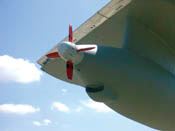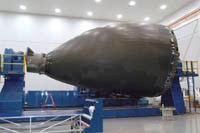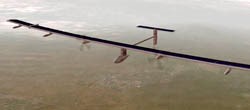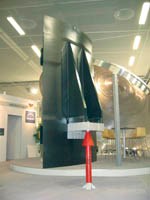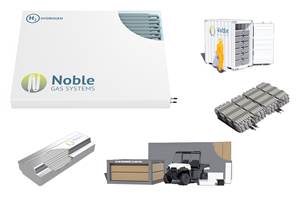Paris Air Show Report 2005
The 46th edition of the world's largest aircraft industry event provides a fitting showcase of composites industry gains.
|
By any measure, this year's edition of the biennial International Paris Air Show, held June 13-19 in Le Bourget, France was one for the record books: More than 1,900 aircraft-related companies exhibited this year, compared to 1,728 in 2003. Moreover, the seven-day event attracted approximately 480,000 visitors, 223,000 of which were aircraft industry trade participants. (This compares very favorably with the 340,000 and 197,000, respectively, recorded two years ago). Total visitor count was 41 percent higher than 2003 and 11 percent greater than in 2001. According to its organizers, the show attracted 238 aircraft, with 19 making their first public appearance. Notable among the debut aircraft were the Airbus A380, the Boeing 777-200LR, Dassault Aviation's Falcon 7X and UCAV Neuron, Gulfstream's G550, Embraer's EMB 195 and Aermacchi's M346. Additionally, 206 official delegations from 88 countries (22 more than in 2003) and 4,000 credentialed journalists were on hand to examine exhibits in 127,500m2 (nearly 1.4 million ft2) of covered exhibit space and an additional 192,000m2 (slightly more than 2 million ft2) outdoors. |
But agreeable statistics don't tell the whole story. The atmosphere among exhibitors was more upbeat than any Paris Air Show in recent memory, particularly for the composite structures companies. This mood of euphoria was largely the result of four new aircraft programs, each with unprecedented ratios of composite-to-metal usage in the structure. Airbus Industries' (Toulouse, France) double-decked jumbo passenger airline, the enormous A380, was the centerpiece. Despite its size, it did an elegant flying display, helped no doubt by the 25 percent of structural weight made from composite materials — 22 percent carbon fiber-reinforced polymer (CFRP) and 3 percent GLARE, a hybrid laminate made up of alternating thin layers of glass/epoxy prepreg and aluminum alloy. Much excitement, however, was stirred by aircraft not yet ready for display at this year's show, but certain to turn up at the next one: Airbus will soon field its A400M military transport with an all-CFRP wing box and 32 composite propellers, as well as all the usual applications of composites to stabilizers, access doors, wheel fairings, wing feathers, etc. This will be followed very rapidly by The Boeing Co.'s (Chicago, Ill.) mid-size, twin-aisle 787 Dreamliner, expected to take it's first flight in 2006, with an industry record of 50 percent composite usage in the structure. And in September this year, Airbus plans to launch the A350 program, its answer to the new Boeing aircraft. The A350 started as a modified A330, the notable feature of which was a new all-composite wing. After a lukewarm reception from the airlines, however, Airbus increased the composite usage to 39 percent and now offers an aircraft with 90 percent new part numbers. Since the change, the orders have come rolling in. There were 95 orders announced at the show, bringing the total to 125 orders in less than six months.
The existing commercial programs are going back to pre-2001 plans to that called for significant production increases. For example, Airbus is planning for 30 single-aisle and eight twin-aisle aircraft per month, beginning in 2006. On top of these new civil opportunities the current programs are looking up, with follow-on orders for military programs such as the Eurofighter and the EH101 helicopter, a/k/a US101, the new U.S. Presidential helicopter.
Majors pitch mid-size models
Airbus and Boeing focused their show marketing efforts on the competition between the 787 and the A350. What is new is that both companies are using advanced materials as sales tools. But the competitors' presentations revealed very different philosophies for fuselage materials. Boeing touted its high composite usage — 50 percent of structural weight, with the only visible metal being the leading edges of the wings and stabilizers. One of the selling points was that CFRP has better resistance than metals to the impacts that a fuselage invariably receives from jetways and airport vehicles. Michael Bair, Boeing 787 program VP, reported that airline customers concerned about how susceptible a CFRP fuselage might be to "ramp rash" will be provided with sample composite and aluminum panels and a hammer, with which they can conduct their own evaluations! A less obvious benefit of a composite fuselage is the ability to leave holes unfilled, which Boeing says it would not do with a metallic structure to avoid potential cracking. Pre-drilling attachment points for optional interior layouts greatly reduces assembly time.
Boeing said that four development composite barrel sections and a nose section have been built, adding that its Everett, Wash. facility is constructing part of a full-scale wing box to demonstrate the manufacturing techniques and support certification. Boeing also released its 2005 Current Market Outlook report, which predicts a $2.1 trillion (USD) market for new commercial airplanes over the next 20 years. It projects a need for about 25,700 new commercial passenger and freighter airplanes during that period, with more than 80 percent of those in single-aisle and mid-size twin-aisle categories. The full report is available online.
Boeing also used the event to showcase its the 747-400 freighter and new KC-767A tanker aircraft developed for the Italian Air Force, as well as its 777-200LR, which will be capable of nonstop service between cities up to 17,446 km (10,840 miles) apart when it enters service in 2006.
Airbus, on the other hand, reported an increase of advanced materials on the A350 to 60 percent, with 39 percent composite and 21 percent aluminum-lithium alloy. But unlike Boeing, Airbus intends to use aluminum-lithium for most of the fuselage structure, using composites only to fabricate the fuselage structure to the rear of the pressure bulkhead and the empennage/vertical tail structure. For Airbus, the main fuselage design driver is accidental damage. The company argues that use of aluminum-lithium will result in less time out of service because maintenance teams will be able to use standard repair procedures in an open hangar, whereas composite repair must be done under more controlled conditions. Given the divergent views among experts in this area, we will probably have to wait until both aircraft have been in service before we know which approach proves most practical.
Both aircraft will use CFRP for the wings. Airbus reported at the show that it hopes to build facilities in the U.K. to make the composites wing components. The company believes the use of CFRP in the wing will save 5 metric tonnes (slightly more than 11,000 lb) per aircraft.
Boeing confirmed its commitment to aluminum for the wing ribs. In most other areas on the 787, titanium is used where metal comes into contact with CFRP, but in the wing, Boeing believes that the fuel stored in the wing will inhibit corrosion at the CFRP-to-aluminum interface. Airbus reports that, while leaning toward aluminum, it has not ruled out carbon fiber composite ribs, and has yet to make a decision.
Frontier of future flight?
On display at the Dassault Aviation (Saint-Cloud, France) stand, another prospective aircraft that attracted much attention in Paris was the Solar Impulse. This solar-powered, electric prop-driven aircraft is to be the first of its kind to take-off and fly around the world entirely without resort to secondary power sources. Conceived by Solar Impulse SA (Lausanne, Switzerland), this ultralight has an even higher composites content than the 787 and the same huge wing span as the A380 (80m/260 ft) but a maximum take off weight (MTOW) of only 2 metric tonnes (about 4,400 lb) compared with the A380's 560 metric tonnes (nearly 1.24 million lb).
To make the trip, the plane must be able to fly through the night. To accomplish this feat, a very lightweight airframe (sandwich panels with high-modulus carbon fibers in the skins) has been combined with an efficient wing design, giving a very low sink rate when gliding from a daylight ceiling of 12,000m/37,000 ft to the night flying altitude of 3,000m/10,000 ft. The potential energy release during this glide plus the energy stored in lithium batteries is expected to be sufficient to allow the aircraft to remain airborne until sunrise the next day.
The program is well into its design phase with support from Dassault, Altran (Paris, France) and a number of other aerospace companies, large and small, as well as interested individuals. Additional sponsors were sought at the show, in an attempt to fully fund what is expected to about a $50 million (USD) effort. The project has yet to add a composite materials supplier to the team.
As a measure of the program's effectiveness at attracting attention, Dassault's chief executive Charles Edelstenne reported that when French President Jacques Chirac visited the stand, he spent all his time discussing the Solar Impulse rather than the Dassault items on display.
Concorde II?
Japan and France announced a joint effort to develop a new supersonic successor to the Concorde, which was retired in October 2003. Japan's Trade Ministry says defense contractors and engineering companies from both countries will share the cost of research, estimated at $1.84 million (USD), over the next three years. Japanese firms include Japan Aircraft Development Corp., Japan Aerospace Exploration Agency, Mitsubishi Heavy Industries Ltd., Kawasaki Heavy Industries Ltd., Fuji Heavy Industries Ltd., and Ishikawajima-Harima Heavy Industries Co. French participants have yet to be announced.
In other news, AAR Composites (Clearwater, Fla.), a division of AAR Corp., announced at the show that it is a member of the Northrop Grumman team selected by the U.S. Department of Homeland Security (DHS) for Phase II of the Counter-Man Portable Air Defense Systems (Counter-MANPADS) program, designed to protect commercial aircraft from attack by ground-based, shoulder-fired missiles. AAR's composites manufacturing operating unit will design custom, aerodynamic composite fairings to house and protect a commercial version of Northrop Grumman's directional infrared countermeasure (DIRCM) system, an anti-missile system currently in production and already deployed on a variety of military aircraft around the world.
The G180 SPn Utility Jet was launched by aerospace manufacturer Grob Aerospace (Tussenhausen-Mattsies, Germany). It combines the performance and passenger comfort of a light business jet with the versatility of a turboprop, the company says. The "Utility Jet" is a carbon-fiber twinjet with a fuselage length and wingspan of just over 14.6m/48 ft and a maximum payload of 1,130 kg/2,491 lb. The aircraft can hold eight passengers and one pilot. Its large door and modular interior make it suitable for quick conversion for cargo or ambulance stretchers. Grob also announced that it has named ExecuJet Aviation Group (Zurich, Switzerland) as the exclusive worldwide sales distributor and maintenance provider. European certification and first customer deliveries are expected soon, with U.S. certification to follow in 2007.
Representatives from nine countries partnering on the Lockheed Martin F-35 Joint Strike Fighter (JSF) gathered at the show and assembled a scale model of the F-35 to demonstrate team solidarity. Delegates from the U.K., Italy, The Netherlands, Turkey, Canada, Australia, Denmark, Norway and the U.S. took turns adding sections of the 1/10th-scale model until it was completed.
Composites on display
Composites industry exhibitors were there in force. Notable among them were the following composite aircraft component manufacturers, whose stands housed a number of new composite parts:
HITCO Carbon Composites (Gardena, Calif.) showcased its application of composites to a very complex air scoop (see photo, this page) used on the refueling pod of Boeing's new mid-air refueling tanker, the KC767A. On display in the static display area was the first completed aircraft, destined for the Italian Air Force. The wing-mounted pod, which contains the retractable hose through which the fuel is supplied, is made by Smiths Aerospace (London, U.K.). HITCO's scoop is a re-engineered version that is 60 percent lighter than the heavy and complex aluminum casting it replaces.
MAN Technologie AG, under new ownership by space group OHB Systems (Bremen, Germany), is focusing totally on the space industry. The company displayed main rocket segments to booster interface attachment lugs made in CFRP. This composite structure is the main load path for the booster thrust and bears a load of 400 tons on each composite lug.
While GE Transportation, Aircraft Engines (GEAE, Cincinnati, Ohio) did not have one of its new GEnx jet engines on hand for the show, the company drew attention to the use of carbon fiber in the engine fan blade containment case, an unusual development in a part historically built with aluminum. GEAE also reported that one of its composite GE 90 fan blades, beautifully prepared on a plinth, is to be displayed at the Museum of Modern Art in New York!
Not the first exhibit one would think to visit when looking for composite innovations, the Alcoa (Pittsburgh, Pa.) stand proved to be one of the most interesting, with hybrid metal/composite structures on display. These were aluminum skin and stringer panels with "selective reinforcement" of Fiber Metal Laminates (FMLs), a family of hybrid materials that include GLARE. Alcoa reported that additional damage-containment features can be incorporated to improve the structure's damage tolerance. In one sample, the reinforcements were located under the stringers and in others between the stringers. Weight savings of 16 to 20 percent are claimed when these methods are used in conjunction with laser or friction stir welding.
On display at the Ratier-Figeac (Figeac, France) stand was the propeller for the Airbus A400M — no less than eight blades per engine, 32 per aircraft. The total weight of the propeller composites for each aircraft is approximately 1 metric tonne (about 2,200 lb). To make the blades, the company uses a braiding machine to lay carbon fibers at 0° and ±45° over a foam core to make the prop's spar. Additional unidirectional material is strategically placed on the spar, then other foam shapes are added for the trailing and leading edges and the whole assembly is covered by a braided Kevlar sock and placed in a tool for the RTM process.
Two unusual composite parts were on display at the Hexcel (Dublin, Calif.) stand. One was a door hinge for the A380, manufactured by aircraft manufacturer Eurocopter, a subsidiary of the EADS Group, at its plant in Donauwörth, Germany. The hinge is made from woven carbon by RTM with Hexcel's RTM 6 resin. This complex part not only saves weight but also conducts less heat from the cabin to the outside when flying at altitude. The other was a thrust reverser cascade made by Plastiremo (a div. of the AeroSafety Systems segment of the Zodiac Group, Issy-les-Moulineaux, France) from HexPly 8552 carbon prepreg. The part was a first for Europe — most cascades today are made in Japan.
The 47th International Paris Air Show convenes June 18-24, 2007.
Related Content
Noble Gas Systems 350-bar conformable pressure vessels pass HGV2 standard tests
Conformable tanks with new materials pass technical tests for hydrogen storage, to compete with Type IV pressure vessels using CFRP.
Read MoreCorebon, Composite Braiding partner to enhance TPC manufacturing
Collaboration aims to overcome production limitations with tubular thermoplastic composites (TPC) by using induction-heated tooling and high-quality commingled braids.
Read MoreCo-molding SMC with braided glass fiber demonstrates truck bed potential
Prepreg co-molding compound by IDI Composites International and A&P Technology enables new geometries and levels of strength and resiliency for automotive, mobility.
Read MoreRead Next
“Structured air” TPS safeguards composite structures
Powered by an 85% air/15% pure polyimide aerogel, Blueshift’s novel material system protects structures during transient thermal events from -200°C to beyond 2400°C for rockets, battery boxes and more.
Read MorePlant tour: Daher Shap’in TechCenter and composites production plant, Saint-Aignan-de-Grandlieu, France
Co-located R&D and production advance OOA thermosets, thermoplastics, welding, recycling and digital technologies for faster processing and certification of lighter, more sustainable composites.
Read MoreVIDEO: High-volume processing for fiberglass components
Cannon Ergos, a company specializing in high-ton presses and equipment for composites fabrication and plastics processing, displayed automotive and industrial components at CAMX 2024.
Read More



